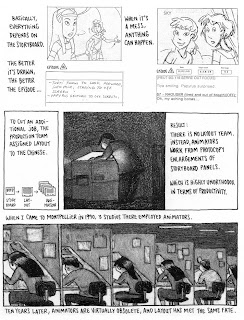Both books are far more travelogues than than they are concerned with animation. They fall into the genre of visitors to new environments who document how life differs from what they are used to. Delisle is an entertaining guide to the two cities. As as he spent months working and living in each, the reader gets a fuller appreciation for the locales than if he was just a tourist who dropped in for a week.
Still, there is interesting material about how animation production proceeds under these circumstances. As I've never worked in Asia, I have no idea how typical Delisle's experiences are but I can't help regretting how TV animation is produced. I can only imagine, based on Delisle's cultural dislocation, how it must be for Asians to be working on Western projects, dealing with languages and cultures they're not familiar with, having to take orders from a foreign boss who can't communicate with them directly and answering to someone who has no understanding of their lives.
Has anyone from Asia written about the experience of working on Western TV animation? If so, can someone please let me know?
If Delisle's writings are accurate, they are proof that animation made for television is created under such broken conditions that an animated performance is an impossibility.


Excerpted from Shenzhen (Click to enlarge)



6 comments:
these comics look interesting, i will have to look into them.
i have never worked overseas myself, so all i know is what people tell me. what he says is happening to layout is too bad. where does this end? animating from a two paragraph outline?
the "leaky boat" analogy sounds very familiar (for different reasons) to the state of animated features. with the constant firing/hiring of key personelle, most movies get made in a constant state of triage. the customary habit of constantly overhauling the story doesn't help.
the panels about how the finished quality of the show is dependent on the graphic quality of the storyboard sounds sensible, but a friend of mine who directed several series that were produced overseas found that this wasn't the case. (this was about ten years ago admittedly) He told me that there was no ryhme or reason to how the quality of the boards effected the show. A good board could yeild a sloppily produced show and a terrible one could result in a tidy and well-executed one. it all depends on the integrity of who does the work. (what a surprise) integrity seems to be the antithesis of this system tho.
Hey Mark,
As one who has worked overseas on several occasions and has sent production work to Asia, I see the depiction as painfully true. The success of a show depends greatly on 1.) your relationship with the overseas studio 2.) the overseas crew assigned to your show, and 3.) the quality and quantity of your pre-production materials. Storyboard for many pre-production studios has become illustration/layout, and in many cases, key animation. There are exceptions in varying degrees but generally speaking, what Delisle has written is true.
Producing animation for TV is all about damage control.
I know and have worked with Guy way back in the 80s. One of the most easy going guys I know, very personable, just an all around great guy.
He has been working in France for many years at La Fabrique d'image in Montpellier. He takes those overseas contracts every once in a while and I believe these are even less glamorous (!) than the usual fare of overseas production.
But he definitely had the right idea in documenting each one he goes to and giving the world an insight of his experience, not just the animation industry, while remaining respectful of each country's culture.
I have never been an overseas supe, but as a director I have dealt with overseas production with results that vary from the very competent to the barely saveable. On some cases the supe would send a fax documenting some of the practices that were done at certain facilities that just defied all logic to try and save a buck.
Guy's books are a must read for someone who wants to supervise overseas, as a heads up.
The description sounds awfully familiar, but I don't work in Asia, I work in Europe. Here it seems to be a rule of business to divide each project between at least three different studios, of which at least one must be in another country. (Oh, the EC officially likes this and gives money to constructs consisting of studios from 3 different countries.) Language is not so much the problem, but maintaining some quality against overall cutting of important work steps is hard. Since there's no real standard workflow pipeline established, we can have several different combinations of drawing and software within the same series, and the storyboard not being drawn fit to any of them.
As a board artist, these conversations make me nervous. Especially when rates keep dropping. I gotta improve quickly.
Post a Comment